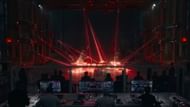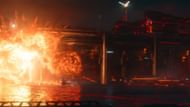Tron: Ares (2025) is the third film in the Tron franchise, directed by Joachim Rønning and starring Jared Leto, Greta Lee, Evan Peters, Jodie Turner-Smith, and Jeff Bridges reprising his role as Kevin Flynn.
Filmed in Vancouver with a score by Nine Inch Nails, it premiered on October 6, 2025.
Set 15 years after Tron: Legacy, ENCOM and Dillinger Systems race to bring digital constructs into reality. When a self-aware program named Ares emerges, human and digital agendas collide, driving a struggle that explores identity, empathy, and the limits of technology.
Tron: Ares expands the franchise with new characters, grids, and technologies, but it also leaves viewers with several lingering questions. From the full implications of the Permanence Code to the fate of key programs and the future of the Grid, many narrative threads remain unresolved.
These unanswered elements continue to spark discussion among fans and set the stage for potential developments in the next installment.
7 biggest unanswered questions after Tron: Ares
1) Who in Tron: Ares acknowledges the events of the first two films?

One of the most striking aspects of Tron: Ares is its selective connection to the earlier entries in the franchise.
While the film references Sam Flynn’s departure from ENCOM and features a post-credits scene in which Ares (Jared Leto) searches for Quorra (Olivia Wilde) from Tron: Legacy, the awareness of these events among human characters is surprisingly limited.
Ares’ knowledge of Quorra aligns with his extensive data access, but this awareness does not extend to the human cast.
Key figures such as Eve Kim (Greta Lee), who assumes leadership of ENCOM, appear unfamiliar with significant events from the prior films, including the particle laser.
This raises questions about the continuity within the corporate world of ENCOM: how could the transformative events of the original Tron and its sequel remain unknown to the broader human workforce, beyond Sam Flynn? The film’s narrative choice shows a curious mix of homage and narrative independence from its predecessors.
2) How is Kevin Flynn still alive in Tron: Ares?

Kevin Flynn’s apparent return in Tron: Ares prompts significant questions, given his sacrifice at the conclusion of Tron: Legacy, where he merged with the rogue program Clu to allow Sam and Quorra to escape.
His reappearance in the new film relies on the discovery of Flynn’s original “retro grid,” a hidden digital environment preserved from the first film.
Within this space, Ares encounters Flynn, guided by the returning Bit, who introduces him to the so-called “malfunctioning program.” Flynn, intrigued, provides Ares with the “permanence code,” a critical plot device in the film.
While his inclusion serves as a key connective element to the franchise, the film offers minimal explanation for Flynn’s continued presence, leaving audiences to reconcile his survival with the events of Legacy.
3) Why do the programs experience pain in Tron: Ares?

The notion of artificial intelligence or digital programs experiencing pain or emotion is well-established in science fiction, yet Tron: Ares presents the concept with a degree of ambiguity.
In the film, Julian Dillinger (Evan Peters) develops advanced technology to project programs from his Grid into the real world, though these constructs can only exist for a limited 29-minute duration.
During this period, the programs appear to experience actual pain when they “derezz,” a phenomenon the film does not fully explain. While the effect seems intended to humanize the digital entities, the narrative inconsistently frames the emergence of emotions as a separate anomaly.
This ambiguity leaves the audience questioning the purpose and mechanics behind the programs’ capacity for both physical sensation and emotional response.
4) Why was the "Permanence Code" introduced in the Tron Universe?

The introduction of the "Permanence Code" in Tron: Ares represents a significant new narrative device within the franchise, functioning as a central motivator for the film’s events.
The code addresses the limitation placed on programs projected into the real world by Julian Dillinger’s advanced technology, which allows them to exist outside the Grid for only 29 minutes.
This restriction raises questions, particularly in comparison to characters like Quorra, who has existed outside the Grid for over a decade without apparent consequence.
The Permanence Code appears primarily designed to generate tension and conflict, creating a time-sensitive obstacle that drives the narrative forward while providing a mechanism for resolving the story’s central stakes.
5) Why is escaping the grid still so complicated?

In the original Tron (1982), the difficulty of entering and exiting the Grid was understandable given the technological limitations of the era. Kevin Flynn’s journey through the particle laser and a fleeting portal created a tense, time-sensitive narrative that added dramatic weight to the story.
However, by the time of Tron: Ares, this mechanism feels increasingly outdated. While the film depicts advanced technology capable of projecting programs into the real world, human characters are still bound to the same cumbersome portal system.
The persistence of this obstacle raises questions about continuity and logic within the franchise, particularly given the technological advances established in the lore of the series.
6) Why are there two ENCOM grids in Tron: Ares?

One of the most significant additions in Tron: Ares is the existence of multiple grids, including the red-lit Dillinger Grid, the modern ENCOM Grid, and a retro version of the original Grid where Kevin Flynn appears.
While the separation of Dillinger and ENCOM grids aligns with their respective corporate functions, the presence of two distinct ENCOM grids raises questions about narrative consistency.
In Tron: Legacy, the ENCOM Grid clearly evolved from the original 1982 Grid, with no indication of a preserved retro version. The inclusion of this older Grid serves primarily as a nostalgic callback and a vehicle for Flynn’s appearance, rather than advancing the plot, showing the film’s focus on visual homage over narrative necessity.
7) Will Ares and Quorra cross paths in Tron 4?

The conclusion of the movie hints at a potential encounter, with Ares exploring the real world and sending a postcard to Eve Kim while glancing at a photograph of Sam and Quorra, signaling his intent to locate them.
However, the film provides no indication of the characters’ exact whereabouts following the events of Tron: Legacy.
Even if a meeting were to occur in a future installment, the narrative significance of such an interaction remains uncertain. Given that both characters now exist outside the Grid with permanence, the purpose of their encounter, beyond reunion or exposition, would need careful justification.
The film’s current trajectory leaves open questions about the potential dynamics and storytelling value of Ares and Quorra sharing the same frame in a prospective Tron 4.
Interested viewers can watch Tron: Ares in theaters now.
